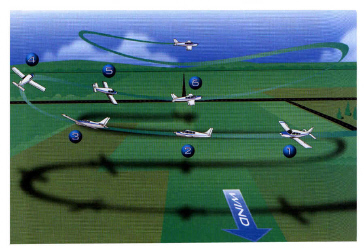Watch on how to fly Lazy Eight
-
- Align your flight path with your initial reference point and establish straight-and-level flight at the recommended airspeed.
- Begin a gradual climbing turn toward the 45° point, increasing pitch attitude while you slowly increase the angle of bank.
- As you pass through the 45° point of the turn, your pitch attitude should be at its maximum and your bank angle should be about 15°.
From 45° to the 90° point you should begin to decrease your pitch attitude to the horizon and continue to increase the angle of bank.
- At 90°, you should be in a level flight attitude, at the maximum angle of bank (approximately 30°), and your airspeed should be about 5 to 10 knots above the stall speed. Then, slowly begin to roll out of the 30° bank and gradually lower the nose for the descending turn as you allow the airspeed to increase.
- When you reach the 135° reference point, the nose of the airplane should be at its lowest pitch attitude. Continue a gradual rollout and allow the airspeed to continue to increase, so that you are in a level flight attitude at your entry altitude and airspeed as you reach 180° of turn.
- At this point you should immediately begin a climbing turn in the opposite direction toward the selected reference point to complete the second half of the eight in the same manner as the first half.
PTS Standards
- Exhibit knowledge of the performance factors associated with lazy eights.
- Select an altitude that will allow the maneuver to be performed no lower than 1,500 feet AGL or the manufacturer’s recommended altitude, whichever is higher.
- Select a prominent 90° landmark in the distance.
- Establish the recommended entry power and airspeed.
- Plan and remain oriented while maneuvering the airplane with positive, accurate control, and demonstrate mastery of the airplane.
- Achieve a constant change of pitch, bank, and turn rate.
- Maintain an altitude and airspeed consistent at the 90° points, +/-100 feet and +/-10 knots, respectively.
- Using proper power settings, attain the starting altitude and airspeed at the completion of the maneuver, +/-100 feet and +/-10 knots, respectively.
- Achieve a heading tolerance of +/-10° at each 180° point.
- Continue the maneuver through at least two 180° circuits and resume straight-and-level flight

